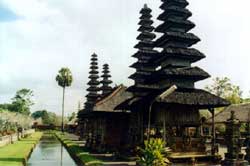More RI tourism spots proposed to be included on World Heritage
List
JAKARTA (indo.com): The Indonesian government has reportedly
proposed to UNESCO that Mount Kawi in East Java, Pura
Besakih in Bali, Sawah Berundak Jatiluwih, Pura Taman
Ayun (also in Bali) and a traditional house Buwomataluwo
in Nias all be included as members of the World Cultural
Heritage List.
"To date, Indonesia has three national cultural
conservation structures that have been included on the
World Heritage List, namely Borobudur Temple, Prambanan
Temple and Sangiran Archaeological Site," Minister
of Culture and Tourism I Gede Ardika said in a hearing
with the House of Representatives recently.
 Last
year the government proposed several sites as members
of the World Cultural Heritage, including Tana Toraja
in South Sulawesi. It has so far received tentative number
1.038 C. "In 2001, five more tourism designated spots
will be proposed," he said. Last
year the government proposed several sites as members
of the World Cultural Heritage, including Tana Toraja
in South Sulawesi. It has so far received tentative number
1.038 C. "In 2001, five more tourism designated spots
will be proposed," he said.
With tourism designated spots included as members of
the World Cultural Heritage, Indonesia would like to demonstrate
that the country pays adequate heed to cultural conservation
endeavors. Indonesia, the minister said, has the intention
of becoming a member of The International Center for Conservation
of Cultural Property (ICROM), one of the three advisory
boards of the World Heritage Committee.
"By becoming a member of the ICROM, Indonesia's
proposals for various sites to be included on the World
Cultural Heritage List will receive an immediate response,
in addition to technical assistance on conservation and
restoration," he was quoted by Antara as saying.
A brief overview of the proposed tourism-designated
spots is as follows:
Kawi Mountain
Mount Kawi is a hill thirty-five kilometers west of Malang,
East Java, and is much visited by pilgrims. Legend has
it that the hermits Eyang Jugo and Eyang Imam Sujono,
once lived here. Their graves are found in the area of
Wonosari Hill, on the slopes of Mount Kawi. Pilgrims consider
these graves to be sacred. The path leading towards Eyang
Jugo's grave is crammed with stalls selling everything
from food to sandals.
Manggis spring is found not far from the Kawi Mountain
complex. There is another spring, called Urip, which according
believers can cure certain diseases.
Pura Besakih
Bali's "mother temple" - the largest and holiest
temple in Bali - is over 900 metres up the slopes of Gunung
Agung. It has been regarded as a holy place in Bali since
pre-historic times. The first recorded mention of its
existence is from an inscription that dates from 1007
A.D. Since the Gelgel dynasty of the fifteenth century,
it has been regarded as a central, holy temple for the
entire island.
All the allegiances of the Balinese people come together
at Besakih. Each regency has its own temple within the
over-all compound, as do each of the caste groups. There
are a total of 18 separate sanctuaries. The three main
temples are: Pura Penataran Agung, dedicated to Sang Hyang
Widi Wasa, Pura Kiduling Kreteg, dedicated to Brahma,
and Pura Batu Madeg, dedicated to Wisnu. To the Balinese,
a visit to the temple sanctuaries at Besakih is a special
pilgrimage. Each temple has its own odalan, or anniversary
celebration, and on the full moon of the Balinese month
"Kedasa" the entire compound of Besakih celebrates
the visit of the gods, with an enormous throng of visiting
pilgrims.
Taman Ayun Temple
This temple is located in Mengwi, 16 kilometers northwest
of Denpasar. The elegant Pura Taman Ayun is the second
largest temple complex on Bali, and one of the island's
most beautiful shrines. This trim, impressive garden complex
lies only one-half km east of the main highway (turn in
at the market), accessible by a long walkway. According
to Babad Mengwi, the original structure was built by I
Gusti Agung Sakti on 1634, the King of Mengwi at that
time. It is partly surrounded by a wide moat with lotuses,
which gives the impression the temple is floating. Restored
and enlarged in 1937, today Pura Taman Ayun is looked
after by descendants of the royal family. It has well-kept
gardens and an orchid nursery.
Jati Luwih
Located some 48 km from Denpasar, and about 28 km to the
north of Tabanan, Jati Luwih has a gorgeous panorama,
with rolling rice terraces and thick forest filled mountains
as its backdrop. Jati Luwih has clean, cool and fresh
air. Historically, Jati Luwih witnessed the construction
of a temple dedicated to the power of the King Ida Dalem
Waturenggong in Gelgel Palace (1460-1551). Travellers
can witness unique religious attractions held once every
210 days on Wali, Petoyan, Patirtan, and Rabu Kliwon Ugu
Day in the Balinese calendar, with sacred Wali Pendet
Dance performed at the peak of the event.
|






 Last
year the government proposed several sites as members
of the World Cultural Heritage, including Tana Toraja
in South Sulawesi. It has so far received tentative number
1.038 C. "In 2001, five more tourism designated spots
will be proposed," he said.
Last
year the government proposed several sites as members
of the World Cultural Heritage, including Tana Toraja
in South Sulawesi. It has so far received tentative number
1.038 C. "In 2001, five more tourism designated spots
will be proposed," he said.